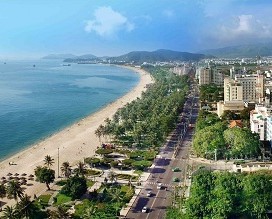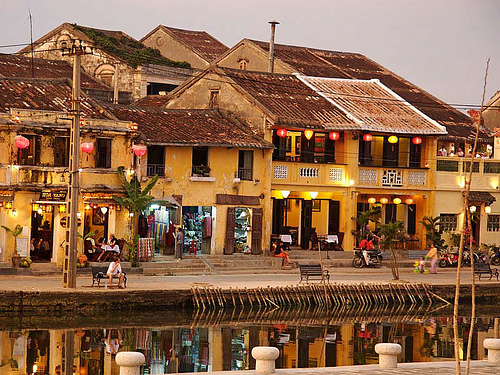It is not commonly known that the history of signboards of shops in Hoi An, Quang Nam province, is the history of the development of this ancient city.
There is nowhere like in this city where the past, the present and the future are as connected to business and nowhere like in Hoi An where signboards of shops can tell so much.
Some of the signboards in Hoi An have been around since the 18th century and they are still hanging on the doors of ancient houses like living proof of the ancient city’s history.
Culture of signboards
On ancient streets of Hoi An, old signboards prevail on doors, giving the ancient city a unique architectural characteristic.
Signboards of shops are very diverse and eye-catching. There are 75 old signboards on the road of Tran Phu and 40 on Nguyen Thai Hoc street, belonging to shops of Vietnamese and Chinese-Vietnamese.
According to the Hoi An Relics Preservation Centre, there are 45 signboards of 100-200 years old and 30 of less than 100 years. Many shops have been known for centuries, such as Duc Hung, Xan Thanh, Van Buu, Tan Ky, Tuong Lan, Chan Nam Hung, Thuan An Duong and Quan Thang San.
Mrs. Thai Thi Sam, 90, at No. 77, Tran Phu road, said: “Quan Thang San signboard is written in Chinese script. It has been used for more than 200 years, since the age of my paternal grandfather. It has been moved several times. Though my family doesn’t do business anymore, we still keep it because it is the brand of my grandparents.”
The old signboard Quan Thang San is now hung on the most beautiful old house in Hoi An. This house is a typical example of the architecture of Hoa Ha region in China. The house’s owner, Mr. Diep Bao Hung, is the 7th descendant of a Chinese captain named Thai Ke Trinh, who traded traditional Chinese medicines with Asian countries.
According to a survey of the Hoi An Relics Preservation Centre, most signboards were made based on the Chinese conception of prosperity and luck. However, the signboard of each house has its own special quality.
Most signboards of Chinese-Vietnamese are written in Chinese and made of wood. They are carved and gilded. Typical examples are Chan Nam Hung, Tuong Lan, and Tan Ky, which are decorated with leaves, flowers, dragons, and cranes.
There are some signboards made of concrete on walls, decorated with patterns, such as Thai Vinh Xuong, Nam Phat and Cam Thach.
Traditional values
Minh Duc Duong signboard, 120 Nguyen Thai Hoc.
The names of signboards tell the history of Hoi An, a commercial port established by the open door policy of the Nguyen Dynasty to boost trade with Chinese, Japanese, Dutch and others.
Signboards also express good things, combining with the names of shop owners.
The signboards like Hoa An Duong, Chan Nam Hung, Bao An Long, Nam Phat and An Thai express the wish to live and work in peace in this southern land by Chinese traders from Fujian, Chiu Chow, Hainan, and Guangzhou.
Annually, signboards are cleaned by a wiping cloth wet with alcohol but they are never painted again. During the lunar New Year holiday, they are decorated with red-cloth flowers. Below the signboards are scrolls of parallel lines of script: “Safe and Sound” or “Prosperous”.
Whenever a shop hangs up its signboard, the owner always chooses a good time and performs rituals with flowers, betel and areca, wine, steamed glutinous rice, boiled chicken, incense and votive paper.
At Chinese shops, there are some more offerings like a bowl of noodles, a piece of red paper on the plate of chicken and steamed glutinous rice to wish for luck and immortality.
Le Thi Tuan from the Hoi An Relics Preservation Centre said that as trade has been the foundation of Hoi An for several centuries so shop owners treasure their signboards. The position of major signboards will never be changed. Each shop has 2-4 signboards, one in the house’s centre, one in the living-room, and another hung outdoors.
“Even when a shop changes its business, the signboard is still kept out of respect to tradition,” Tuan said.
Modern meanings
The famous La Thien Thai shop.
There is nowhere like in Hoi An where signboards contain intangible cultural values. By looking at signboards and talking with signboard owners, one can learn about the life, habits and trade history of a family and the prosperity of Hoi An from the past to the present. Thus, the local government has regulations to manage signboards.
According to the chief of the Hoi An Department of Culture, Sports and Tourism, Nguyen Van Lanh, in 1997, Hoi An issued the first regulations on signboards in the ancient city. These regulations are very strict and based on the traditional way of using signboards at shops in Hoi An.
“Hoi An can both develop business, tourism while preserving its traditional values when it preserves its unique signboards,” Lanh said.
According to regulations, signboards must be clear, of standard size and suitable to the traditional style of Hoi An.
In region 1 of the ancient city, signboards must have brown, stone, dark yellow colours. The local authorities encourage traders to use wood to make signboards. The script on signboards must be Vietnamese.
Of nearly 1,000 signboards in Hoi An, around 70% are made of timber and done in the traditional style.
Hoi An will continue to introduce its culture to tourists through this system of unique signboards.
Visa to Vietnam can be applied on Vietnam-visa.com




